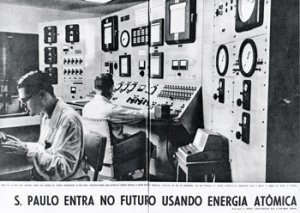
Ipen Archives Article in the Manchete magazineIpen Archives
Brazil entered the nuclear age with pomp and circumstance. The nuclear research reactor IEA-R1, donated by the United States under the Atoms for Peace program, which made it possible for other countries to go into nuclear power, was opened in 1958 by President Juscelino Kubitschek and by Governor of São Paulo, Jânio Quadros. Two years before, an agreement between the University of São Paulo (USP) and the then National Research Council (now CNPq) created the Atomic Energy Institute (IEA), a national body for researches in the nuclear area. Heading up the work was Marcello Damy de Souza Santos, a respected physicist and the institute’s first superintendent.
Those were the days in which the atom had star status in science. Projects connected with the nuclear sector stood a better chance of winning government funds, and there was the promise of having abundant electricity. “The prospects for anyone wanting to go into this area were marvelous”, says physicist and historian Ana Maria Pinho Leite Gordon, author of a doctoral thesis in which she analyzes the history of the Institute of Nuclear Energy and Research (Ipen), the current name for the IEA. “All the conditions for creating a center in this sector in Brazil were in place.”
The institute began to be constructed in September 1956. The laboratories for researches in nuclear physics, reactor physics, radiobiology and radiochemistry were created and installed in the following years. It so happened that, with the passage of time, the enthusiasm for nuclear power and the resources dwindled, although the researchers were not contaminated by the despondency. “Almost everything happened at Ipen thanks to the grit of the researchers, who knew how to evolve and adapt themselves to the conditions, even when there was little money for research”, says Ana Maria.
Even with few resources, Ipen continued to grow. One of the sectors that became most important was the production of radioisotopes used in nuclear medicine, in particular in radiodiagnosis and therapy. Postgraduate studies began in 1975, although since the beginning there was a concern over training highly specialized personnel.
Today, there are 400 postgraduate students. Up until the 1990s, Ipen’s only customer was the State, and they realized that the institute’s survival lay in opening up to other sectors. Research with lasers, for example, had always been directed towards the enrichment of uranium. “When the budget for research in the area of the fuel cycle decreased, they started to target non-nuclear areas: growing crystals, developing lasers and their applications in the industrial area and in dentistry.”
This change of direction was also valid for other areas: environmental chemistry, biotechnology, alternative energies, and others. Today, Ipen is connected with the State of São Paulo, associated to USP, and managed by the National Nuclear Energy Commission, of the Ministry of Science and Technology.
The old IEA-R1 reactor continues to be fully functional, producing radioisotopes for the whole of the country. In these years, it has undergone just a few reforms, aiming more at safety.